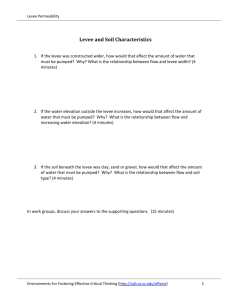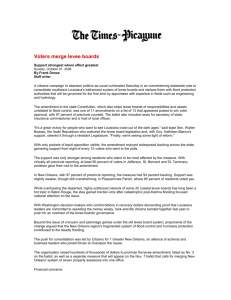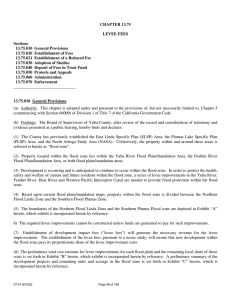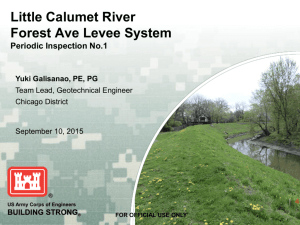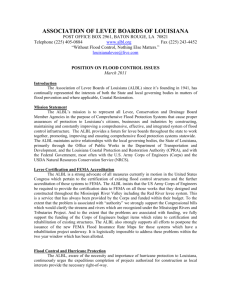September 2006 Measures Briefing Document
advertisement
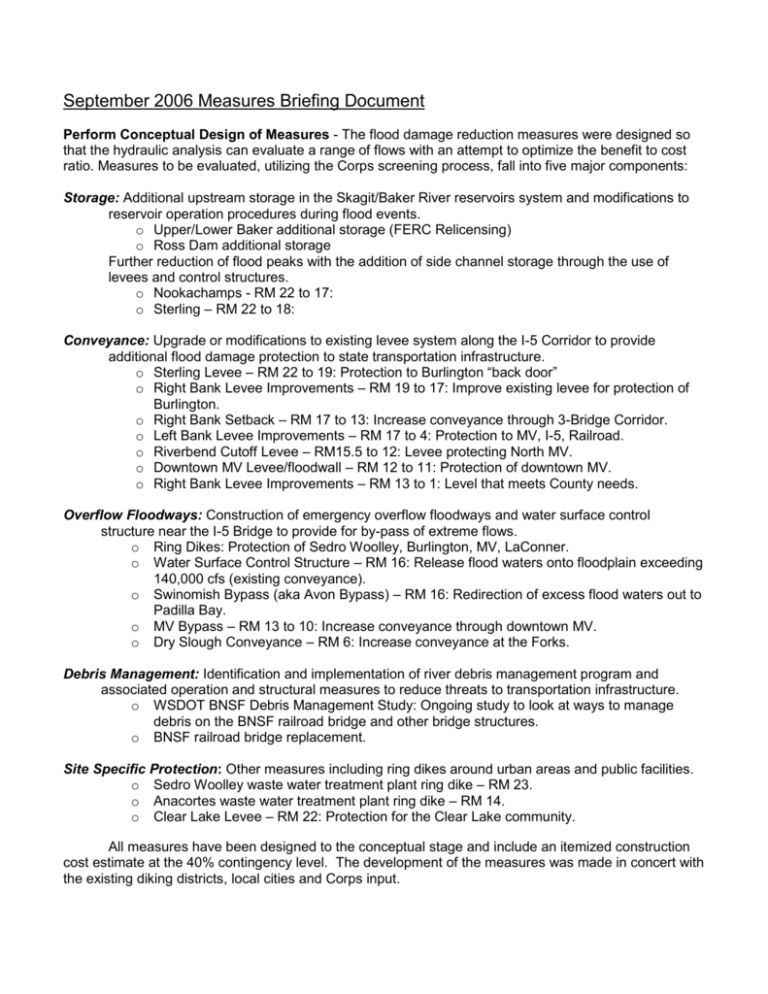
September 2006 Measures Briefing Document Perform Conceptual Design of Measures - The flood damage reduction measures were designed so that the hydraulic analysis can evaluate a range of flows with an attempt to optimize the benefit to cost ratio. Measures to be evaluated, utilizing the Corps screening process, fall into five major components: Storage: Additional upstream storage in the Skagit/Baker River reservoirs system and modifications to reservoir operation procedures during flood events. o Upper/Lower Baker additional storage (FERC Relicensing) o Ross Dam additional storage Further reduction of flood peaks with the addition of side channel storage through the use of levees and control structures. o Nookachamps - RM 22 to 17: o Sterling – RM 22 to 18: Conveyance: Upgrade or modifications to existing levee system along the I-5 Corridor to provide additional flood damage protection to state transportation infrastructure. o Sterling Levee – RM 22 to 19: Protection to Burlington “back door” o Right Bank Levee Improvements – RM 19 to 17: Improve existing levee for protection of Burlington. o Right Bank Setback – RM 17 to 13: Increase conveyance through 3-Bridge Corridor. o Left Bank Levee Improvements – RM 17 to 4: Protection to MV, I-5, Railroad. o Riverbend Cutoff Levee – RM15.5 to 12: Levee protecting North MV. o Downtown MV Levee/floodwall – RM 12 to 11: Protection of downtown MV. o Right Bank Levee Improvements – RM 13 to 1: Level that meets County needs. Overflow Floodways: Construction of emergency overflow floodways and water surface control structure near the I-5 Bridge to provide for by-pass of extreme flows. o Ring Dikes: Protection of Sedro Woolley, Burlington, MV, LaConner. o Water Surface Control Structure – RM 16: Release flood waters onto floodplain exceeding 140,000 cfs (existing conveyance). o Swinomish Bypass (aka Avon Bypass) – RM 16: Redirection of excess flood waters out to Padilla Bay. o MV Bypass – RM 13 to 10: Increase conveyance through downtown MV. o Dry Slough Conveyance – RM 6: Increase conveyance at the Forks. Debris Management: Identification and implementation of river debris management program and associated operation and structural measures to reduce threats to transportation infrastructure. o WSDOT BNSF Debris Management Study: Ongoing study to look at ways to manage debris on the BNSF railroad bridge and other bridge structures. o BNSF railroad bridge replacement. Site Specific Protection: Other measures including ring dikes around urban areas and public facilities. o Sedro Woolley waste water treatment plant ring dike – RM 23. o Anacortes waste water treatment plant ring dike – RM 14. o Clear Lake Levee – RM 22: Protection for the Clear Lake community. All measures have been designed to the conceptual stage and include an itemized construction cost estimate at the 40% contingency level. The development of the measures was made in concert with the existing diking districts, local cities and Corps input. With the development of the flood control project, some areas may not receive 100-year protection and a variety of floodplain management techniques will need to be evaluated. This may include buy-outs, elevation of structures, flood proofing, and changes to the current zoning and regulations to prevent development in areas that have been identified as flood prone. Perform Evaluation of Measures - Each of the measures developed for consideration will be evaluated in terms of a conceptual design, capital and annual operation and maintenance costs, environmental impacts, community acceptance and reviewed by the Corps. The Corps HEC-RAS hydraulic models, developed for the Skagit River from Concrete to Skagit Bay, will be used to perform a detailed hydraulic evaluation as part of the screening of the flood reduction measures. Flood flow and flood stage information from this analysis will be used to size project measures. The hydraulic evaluations will take place on a reach-by-reach basis so that impacted cities, towns and diking districts can readily identify and evaluate their particular interest. The Corps HEC-FDA model will be used to show the flood damage reduction benefits of each measure, which when compared with the total cost of the project you get a cost-to-benefit ratio. Measures will be evaluated in various combinations to help identify a least cost approach and sequence for the implementation of measures to preclude adverse impacts to other areas along the river. A report summarizing the evaluation of combinations of measures (alternatives) will be prepared and distributed to all interested groups. The report will include estimated costs, time schedules and preliminary environmental assessment that will identify potential impacts and/or opportunities for enhancement of habitat related to the flood control features. The design and cost estimates will be prepared in sufficient detail that implementation plans can be developed and financing options explored during the next phase of the project. Currently, the Corps of engineers is performing the hydraulic analysis of the proposed measures. As a result, some levee alignments and elevations have been revised to improve functionality and keep costs down. The Corps HEC-FDA model is undergoing a technical review and the Draft Lower Basin Environmental Baseline report has been reviewed and awaiting response to comments submitted last March. Corps should be beginning work on the upper basin environmental report soon. The County is compiling real-estate costs for the proposed measures as well as calculating project costs for earlier proposed alternatives.




